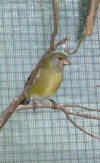. Hooded yellow siskin

Aviary Notes: Read notes on "Finches - Non Australian" web page and use in conjunction with details outlined on this page. Level Of Knowledge Required: Beginner / Intermediate / Advanced / Specialist Breeders Only. Government Regulations & By-Laws: Refer to "Government Laws" web page. Housing Requirements: Click on "Housing birds" web page for general details on the housing of Non Australian Finches or read on for specific details for this finch. Can be bred in canary breeder cages. Was used to develop the red factor canary. It does well in a planted aviary. These birds are from a warm to hot environment so extra care should be taken in the southern Australian States if the birds decide to breed in cooler months or if the weather turns cold. Birds may breed year round in a bird room if conditions are suitable. Diet / Feeding: Click on "Feeding birds" web page for general details on the nutrition of Non Australian Finches or read on for specific details for this finch. Good quality finch mix, seeding grasses and some fruits (e.g. apple) and vegetables. It is possible to breed these birds without live foods but better results are achieved if an adequate supply of insects are available. Sprouted or soaked seed if available. Basic seed mix should include Canary seed, White French Millet, Japanese Millet, and Yellow and Red Panicum. Nesting: A basic overview only.
More details on finch nests and a selection of finch nest photos can be located on the "nests", "finch nests" and "finch nest photos" web pages. Click on "Up" then "nests" then "finch nests" and "finch nests photos" in the navigation bars. Breeding: Egg Colour Pale blue. Clutch/s per year 2 - 3. Eggs per nest 2 - 4. Incubation approx. 13 - 14 days. Fledge approx. 18 days. Independent approx. another 4 - 5 weeks. The hen feeds the young in the nest, but both parents feed the young when they leave the nest. To maximize production or in the case of accidents to a parent bird the eggs and young can be fostered by canaries. Siskins must be removed from the canary foster birds and placed back into a Siskin environment as soon as they are fully independent. Will hybridize with some other finches, canaries, the European Siskin and the Red Siskin. In the planted aviary the nest is usually built at mid level i.e. about 1 - 2 metre height and usually built by the hen.. Artificial incubation, hand rearing or fostering will not be covered on this web site. It is too complex and diverse in nature to be attempted here. Refer "Specific References" as listed below and "General References" listings. Health Issues: Refer "Avian Health Issues" web page for information and references.
General References: Refer to references listed on "Book References" web page. Specific References:
|